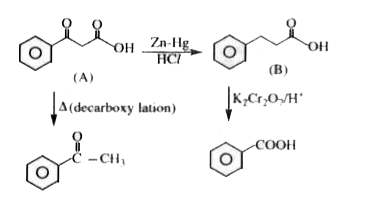Compounds A(C9H8O3) on reduction with Zn-Hg&HCI gave a carboxylic acid B(C9H10O3). B on further oxidation gave bezoic acid. A on strong heating gave a ketone C(C8H8O). C reacts with I2−, NaOH to give yellow solid along with a salt. The salt on treatment with acid gave benzoic acid. Study the paragraph carefully and answer the following questions give below
The structure of 'A' is Solution in Telugu




The correct Answer is:A
Topper's Solved these Questions
- BOOK - AAKASH SERIESCHAPTER - ALDEHYDES AND KETONESEXERCISE - PRACTICE SHEET-334videos
ALDEHYDES AND KETONES
- BOOK - AAKASH SERIESCHAPTER - ALDEHYDES AND KETONESEXERCISE - Solved Problem33videos
ALDEHYDES AND KETONES
- BOOK - AAKASH SERIESCHAPTER - ALDEHYDES AND KETONESEXERCISE - PRACTICE SHEET-130videos
ALDEHYDES AND KETONES
- BOOK - AAKASH SERIESCHAPTER - ALCOHOLS, PHENOLS AND ETHERSEXERCISE - ETHERS (OBJECTIVE EXERCISE-4)50videos
ALCOHOLS, PHENOLS AND ETHERS
- BOOK - AAKASH SERIESCHAPTER - ALKYL AND ARYL HALIDESEXERCISE - OBJECTIVE EXERCISE - 4 (ASSERTION (A) & REASON (R) TYPE QUESTIONS)19videos
ALKYL AND ARYL HALIDES
Similar Questions
Which of the following is likely to highest melting point
13:04View SolutionGive the common and IUPAC names of the compound , CH2=CH−CO−CH=CH2
View Solutioncyclohexene CI2/hv−−−−−−−−−−−→Monoha logenetion AalcKOH−−−−→B(1)O3−−−−−−−→(2)Zn/H2O products . The final product in the reaction sequence above
View Solution(A): Alcoholic fermentation involves conversion of sugar into ethanol by the action of yeast.
(R): Fermentation involves the liberation of CO2 gas.View Solution(A) Towards SN2 reaction, order of reactivity is CH3Br>CH3CH2Br>(CH3)2CHBr>(CH3)3CBr.
(R) Greater the stability of carbocation, greater will be its ease of formation from alkyl halide and faster will be the rate of SN1 reaction.03:46View SolutionA substance(X) contains 41.37%C,6.89%H.0.166gm of (X) gaveNH3 which was absorbed in50ml of N/10H2SO4.The excess of acid required 30mlof N/10NaOH for neutralisation.(X)on treatment withHNO2gave succinc acid (X)on heating lostNH3 to give(A).(A) reacts withBr2and NAOH to give(B) containing 41.02%C,5.88%H, and 11.96%N.(B)on further treatment withBr2and NaOHgives (C)(3-amino propanoic acid).(C)reats withNHO2 to give β-hydroxy-propanoic acid.
Compound (B) is:01:17View SolutionWhen an orange coloured crystallc compound [A] was heated with common salt and concentrated sulphuric acid , an orange red coloured gas [B] was evolved. The gas [B] on passing through NaOH solution gave a yellow solution [C] . The solution on reacting with an aqueous solution of lead acetate gave a yellow precipitate.
The crystalline compound [A] is:02:07View SolutionWhen an orange coloured crystallc compound [A] was heated with common salt and concentrated sulphuric acid , an orange red coloured gas [B] was evolved. The gas [B] on passing through NaOH solution gave a yellow solution [C] . The solution on reacting with an aqueous solution of lead acetate gave a yellow precipitate.
This gas [B] is :03:18View SolutionWhen compound (A) is oxidised by acidic K_2Cr_2O_7 gave (B). Compound (B) on reduction with LiAlH_4 gave (A). The compound (A) and (B) are respectively
03:22View SolutionCompound A reacts with PCl5 to give B which on treatment with KCN followed by hydrolysis gave propionic acid. What is A and B respectively?
06:27View SolutionCompound A reacts with PCl_(5) to give B which on treatment with KCN followed by hydrolysis gave acid as the product. What is A?
04:26View SolutionCompound A reacts with PCI, to give B which on treatment with KCN followed by hydrolysis gave propanoic acid. What is A and B respectively?
04:19View SolutionAn organic compound ‘A’ on treatment with KCN gave B which on hydrolysis with dil. HCl gave acetic acid. Identify A.
02:02View SolutionCompound A reacts with PCI_5 to give B which on treatment with KCN followed by hydrolysis gave propionic acid. What are A & B respectively?
View SolutionCompound A(C_8 H_7 OCl) on reaction with one equivalent of CH_3 MgBr gave B(C_9 H_(10)O) B gives codoform reaction and the other product form in this reaction C which on acidification gave D(C_8 H_8 O_2) . Further B on oxidation gave E(C_7 H_6 O_2) . Both D and E liberate CO_2 on reaction with NaHCO_3 . The compound 'B' is
View Solution


